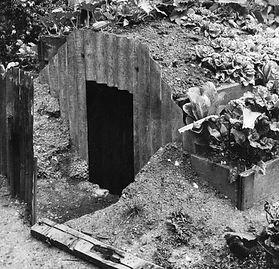

Norman Thurrell was given this Ration Book by his Mother

Norman Thurrell remembers Ration Books and Gas Masks.
Norman Thurrell remembers Gas Masks.
The video here is owned by
http://www.PublicDomainFootage.com
More videos like these can be found on their site
Jack Donnelly remembers Home Guard and minding his Army Dad's Rifle at the age of 7, when his Dad went to the pub, whilst on leave. Jack remembers seeing German V2 Rockets flying over England.
Margaret Willans remembers seeing the Belsen Concentration Camp in the Cinema. Vivid memories of staving people, being liberated.
RARE COLOUR FILM - NAZI V2 ROCKET FACILITY courtesy of RALPHLAURINO YouTube
Belsen Concentration Camp's Liberation (1945) WARNING: DISTRESSING FOOTAGE - courtesy of War Archives YouTube
George Sutton remembers having no tooth paste and brushing his teeth with salt. George remembers the indoor Morrison Shelter, which was not as a good as the Anderson Shelter. 1st interview.
Peter Callaghan recalls living near an Aerodrome where his Dad worked and York being a Hub for travel for the Soldiers and Sailors. He went 6 years without seeing his Dad during WW2.
Shelagh O'Neill remembers Ringway Airport, now called Manchester Airport was used for German Prisoner of War Camp and towards the end of the War, prisoners were allowed to have Sunday tea with Wythenshawe residents, including Shelagh's family and she visited one in Germany after the War.
Elsie Fleury remembers her Dad sure she was safe in their Air Raid Shelter.
Terry Galway remembers his Uncle died when a bomb landed on his house, yet the dog was found alive in the cellar over 2 weeks later.
Marjorie Smith was evacuated in World War 2 and she liked her foster parents so much, she remembers she wanted to stay with them.
Lilian Loftus first interview. Lilian has clear memories of her life during World War 2 because she wrote about it calling this 'War Time'.

Morrison Shelters were a way of protecting people from in their own homes from falling bombs. This was an alternative to the Anderson Shelter in the garden and the public shelters.
This type of protection was named after the Home Secretary, Herbert Morrison. The shelters were made of very heavy steel (almost like a cage) and could be put in the living room and used as a table. One wire side lifted up for people to crawl underneath and get inside. Morrison shelters were quite large two or three people could sleep in them.
Margaret Hobson has lived in Wythenshawe since 1947 and she has clear memories of WW2.
Joe McShane has very interesting observations and recalls historical facts from his childhood, about World War 2.
Joan Starr recalls memories and her Mother's stories relating to WW2. We thank Joan for being a person that helped Community Media Crew deliver this project.
Trudie Patoir worked assembling Aircraft and she married the man she worked with. They have been together for over 70 years.
Marlene Olentunde was born in Gernmay and remembers her first taste of chocolate was from a British Soldier.
Fred Camm remembers Manchester being on fire and the devastation caused by the Luftwaffe air raids.
Ivy Hilton discusses working hard in a Bakery and missing her boyfriend who was in the Royal Navy.

Elsie Stokes has memories of having to 'make do and get and mend to make the best of what you had' during World War 2 when she was at school.

German U-boats Surrender at Lisahally, Near Londonderry, Northern Ireland, 24 - 25 May 1945
Sadie Booth was in Londonderry in Northern Ireland as a young girl in WW2. Sadie remembers German U-Boat submarines were captures and some surrendered. She used to play on these as a child, because her Uncle was in charge of the dock. Photographs courtesy of 'Derry Journal'.

Anderson Air Raid Shelter.
Designed in 1938 and named after Sir John Anderson, Home Secretary during the Battle of Britain, this type of air-raid shelter was designed for use in the garden. When covered with earth the shelter would give some protection from shell fragments and bomber splinters although dampness was an always a problem.
Designed to accommodate up to six people the government supplied them free to low income families and later sold to others to wealthier people. 1.5 million Anderson shelters were distributed in the months immediately leading up to the outbreak of war. When production ended 3.6 million had been produced.
Violet Robinson remembers enjoying being in the Air Raid Shelter, even though the bombings were frightening her.

Dora Durham remembers being blown out of her bed, because of a bomb being dropped near where she lived.
Catherine Nolan, remembers life in Wales during WW2 and the Black Market to achieve getting food from Farmers.
Renee Savage remembers her Mother was from Poland and the Jewish community settled in Manchester in the Broughton area.
Anita Gold recalls her Father was in the Home Guard and it reminds her of 'Dad's Army'.
George Sutton's 2nd interview.
Sheila Gottlieb recalls an Air Raid where her Father was injured and unfortunately died the next day in Withington Hospital which was then called Nell Lane Hospital.
Shirley Friedman recalls being unhappy when she was evacuated and living with another family, until her Father brought her back home.
Lilian Loftus interview two, memoirs from her detailed gathering of notes.
Ruth recalls her Mother trying to not frighten her when explaining what the Air Raid noise was.